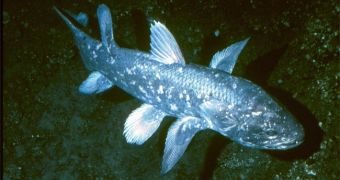The "dinosaur" of all living fishes is the coelacanth from the Indian Ocean. Scientists have been investigating the coelacanth, whose ancestors gave rise to amphibians (and due to further evolution to us) to understand the origin of our limbs.
But a newly found 400 million-year-old fossilized fin from an odd primitive fish is explaining more the way fins evolved into limbs that enabled our ancestors to walk on land.
The fossil fin comes from an ancestral coelacanth (lobe-finned fish) and is the only skeletal fin found till now coming from the extinct relatives of the present-day coelacanths. The four-inch-long (10 centimeter-long) specimen was discovered at Beartooth Butte in northern Wyoming and was named Shoshinia arctopteryx after the Shoshone people and the Shoshone National Forest.
The species could have reached about 18 to 24 inches (46 to 62 centimeters) in length. It appears that the arrangement of bones within the fossil fin is similar to patterns encountered in primitive, living ray-finned fishes, like sturgeons and paddlefishes. But the Shoshinia patterns don't fit the lobe-finned fish's living relative, coelacanths and lungfish.
"Two living fossils, coelacanths and lungfishes, are in fact not primitive," said lead author Matt Friedman of the University of Chicago.
"They are specialized, and they are not particularly good models for understanding the origin of limbs."
Indeed, modern coelacanths, Latimeria, are adapted for deep-waters off the coasts of eastern Africa and Indonesia where they employ a specialized organ in their noses to track down weak electrical signals coming from prey located in the mud along the seafloor.
While the fins on living coelacanths and lungfishes are symmetrical, the fossil fin has an asymmetrical pattern in which more bones are located on the front of the central shaft than the back. It looks more similar to the anatomy of four-limbed vertebrates (humans included) than with the anatomy of living coelacanths.
"To understand the developmental evolution of the limbs of tetrapods, we shouldn't be looking at the fins of our nearest living fish relatives-lungfishes and coelacanths-because they're far too specialized," said co-author Michael Coates, a University of Chicago biologist.

 14 DAY TRIAL //
14 DAY TRIAL //